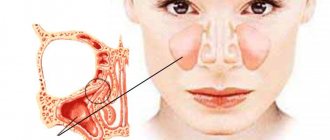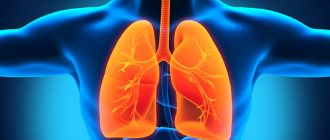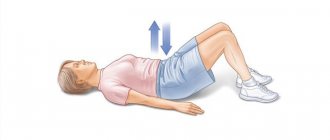1.General information
Shortness of breath (dyspnea) is a deviation of the frequency, depth and/or rhythm of breathing from similar indicators of a healthy person of the same sex and age under the same conditions. Despite some cumbersomeness of this definition, it seems quite complete and accurate. The term “shortness of breath” seems intuitive, which often leads to misunderstandings between the doctor and the patient, who put different meanings into this word.
There are several classifications of shortness of breath:
- inspiratory (on inspiration), expiratory (on exhalation) and mixed (difficulties in both phases of the respiratory act);
- tachypnea (rapid shallow breathing) and bradypnea (slow breathing);
- physiological shortness of breath (transient, reversible intensification of breathing as an adequate adaptive response of the body to stress, injury or objectively low oxygen content in the inhaled air, which requires additional oxygenation) and pathological shortness of breath (caused by airway obstructions, bad habits, cardiovascular failure, obesity, diseases lungs, hematopoietic system, etc.).
This material is devoted to a type of dyspnea called dyspnea at rest (sometimes also called dyspnea at rest). In contrast to the antonymous “shortness of breath on exertion,” which is sometimes difficult to distinguish from the normal physiological response of the respiratory system, resting dyspnea is a much more unfavorable clinical and prognostic sign.
Sign up for a consultation
A must read! Help with hospitalization and treatment!
2. Reasons
The most common causes of shortness of breath at rest (which also includes dyspnea under minor physical exertion, which does not cause changes in breathing in healthy individuals) are:
- cardiovascular failure, when normal blood circulation is disrupted, stagnation and swelling occurs in the lungs, gas exchange slows down and, as a result, hypoxemia develops (deficiency of bound oxygen in the blood);
- disturbances in the regulation of breathing on the part of the central nervous system (brain respiratory center) in certain neuropsychiatric disorders;
- pulmonary pathology (a wide range of diseases affecting the pulmonary parenchyma and/or airways);
- renal or liver failure, causing disturbances in general metabolism;
- diabetes mellitus and other endocrine disorders;
- diseases of the hematopoietic system (primarily anemia as a lack of red blood cells and hemoglobin, of which they are carriers);
- pathology of the spinal column and musculoskeletal structures of the chest.
Visit our Pulmonology page
How to treat shortness of breath
Shortness of breath is a condition that recurs periodically. At first, a person suffering from it often does not pay attention to it. This happens especially often in situations where such a condition is caused by increased physical activity. In this case, many are sure that difficulty breathing is a must.
This is explained by the fact that most people believe that during serious physical exertion, shortness of breath always appears and this is normal, especially when it goes away quickly. Despite this, doctors say that this condition is not always harmless and can be a symptom of the presence of some serious diseases. For this reason, if someone begins to feel out of breath when walking or doing relatively light exertion, it is best for them to consult a specialist.
How can you tell if a person is short of breath?
Shortness of breath is characterized by the fact that the patient’s breathing frequency, rhythm and depth are disturbed. He begins to feel a lack of oxygen. In this condition, as a rule, the lack of air in the body is restored.
The causes of shortness of breath and lack of air often lie in increased physical activity. In addition, this condition may indicate that the patient has a serious illness. Experts divide shortness of breath into several types. Particular concern should be caused by chest pain that appears suddenly. It increases rapidly and the person feels suffocated. In the most serious situations, there may be a threat of asphyxia.
You should be concerned if difficulty breathing occurs after eating or when the person is at rest. It can become one of the manifestations of many diseases. This condition often appears in expectant mothers, especially in the later stages. It occurs in people with heart and lung diseases. Often shortness of breath accompanies diseases of the nervous system, thoracic osteochondrosis, etc.
Types of disease and its causes
Symptoms of shortness of breath vary. It all depends on what specific reason it is caused by. For example, problems with the respiratory center lead to central pathology. Most often it appears due to damage to the central nervous system. In addition, a similar appearance may appear due to the adoption of neurotropic poisons. It differs from others in that there is respiratory failure. There are other types:
Pulmonary. It occurs in people who suffer from various diseases of the bronchi and lungs. It is also noted in pulmonary failure. There are two types: expiratory dyspnea and inspiratory dyspnea.
The first is observed in patients with bronchial asthma. The main symptom is long and difficult exhalation. The reason for this phenomenon is that the excretion of carbon dioxide is impaired, because with such a pathology there is a narrowing of the small bronchi. Thus, in order to exhale, the patient must significantly strain the breathing muscles. To do this, you have to waste most of the oxygen received during inhalation. Because of this, expiratory shortness of breath is characterized by an exhalation that is longer than usual.
Inspiratory occurs in a situation where the patient has pneumothorax of the valve, various damage to the diaphragm, fibrosis. In addition, this type is observed in patients with lymphogenous pulmonary carzonomatosis. A characteristic feature of this type of pulmonary dyspnea is difficulty breathing. This occurs because the lung tissue becomes inelastic. Another option for this type of illness is that the volume of the chest becomes smaller.
The pulmonary type of difficulty breathing is often caused by obstruction of the bronchi. The cause of this problem is swelling of the bronchi. This organ becomes clogged with phlegm. To eliminate the problem, it is necessary to determine its cause and carry out its correct therapy.
Heart. A similar phenomenon occurs in people due to heart failure of the left ventricle. This leads to insufficient blood circulation and stagnation in the lungs. It can also be triggered by a small cardiac output, as a result of which the brain does not receive sufficient nutrition. For this reason, cardiac dyspnea has a disease development mechanism similar to the central one. If the patient is very physically stressed, then in the presence of heart failure, the manifestations of difficulty breathing become stronger. In this case, it often becomes difficult for a person to breathe at night, during sleep.
Taking into account that these types of shortness of breath appear as a result of several mechanisms, the specialist prescribes a complex of medications. The main medicine for such a disease is diuretics. An infusion of foxglove, etc. is used. If the situation is complex, specialist intervention is necessary. If it becomes very difficult for a person to breathe, you should definitely invite a doctor to your home. Before his arrival, first aid must be provided. It is necessary for the patient to be in a semi-sitting position. In addition, you should offer him sedatives, which it is advisable to keep in the house at all times. Usually a person is able to determine for himself what level of physical activity, if exceeded, can lead to an attack.
Hematogenous. Appears when there are toxic substances in the patient’s blood. A similar type of illness is observed in case of any poisoning, diabetes mellitus. It also appears in liver failure.
Shortness of breath may result from pneumonia. In this situation, there is not enough oxygen due to the fact that the volume of lung tissue, which continues to function normally, is reduced. In addition, the level of the respiratory reflex decreases. Difficulty breathing during pneumonia is also observed due to the action of toxic products entering the blood. With increased physical activity, a patient with pneumonia develops severe signs of shortness of breath. In such a situation, correct diagnosis is of great importance. The main thing is that everything is done on time. If you do not do this in a timely manner and are treated exclusively with folk remedies, you can get quite serious problems.
You should be especially attentive to older people. It is necessary to determine where their shortness of breath comes from, the reasons for its occurrence, because, for example, with pneumonia, it can be a sign of the presence of this disease. Often, cardiac and pulmonary types have the same manifestations, so correct diagnosis and prescription of optimal therapy are of great importance.
Cerebral. Formed as a result of irritation of the respiratory center. This type of shortness of breath often appears due to brain damage or dysfunction of the nervous system.
Bronchial. Such shortness of breath is a consequence of inflammation of the lung mucosa. If the symptom appears in children, this may indicate the presence of an acute form of the disease. Distinctive features are lack of oxygen in the lungs. Even with little physical activity, the child begins to cough and has difficulty breathing.
Severe shortness of breath in very young children is the main symptom of obstructive bronchitis. In addition, the disease is characterized by weakness and unhealthy condition. Small children are capricious and lose their appetite. At the same time, they cough heavily all the time. It is necessary to take immediate measures to prevent the disease from developing. Otherwise, the bronchial tissue may change pathologically.
However, shortness of breath in children can be caused by completely different reasons. Therefore, the baby’s parents should not self-medicate and when the first symptoms appear, they should take him to a doctor who will examine the child and make the correct diagnosis. The most important thing is to do this in a timely manner, then the effect of treatment will be much better.
It is strictly not recommended to choose methods of treating bronchial shortness of breath on your own. If you use only folk recipes, you can bring the disease to the point where the acute form of bronchitis becomes chronic. The result may be that in this case the condition becomes more pronounced. You should know that after bronchitis, the immune system of children is significantly weakened, so it will be necessary to strengthen it.
Difficulty breathing combined with a dry cough in adults may also indicate the presence of chronic bronchitis. By these signs you can recognize a heavy smoker. Shortness of breath also occurs with a cold and is often accompanied by high fever.
This phenomenon is also observed in pregnant women. This usually happens late in pregnancy and occurs because the uterus enlarges, causing compression of the diaphragm. In the first months, expectant mothers rarely experience shortness of breath. But sometimes it appears in the first trimester. The reason for this is hormonal changes in the female body.
In addition, this can happen due to increased physical or emotional stress. If shortness of breath in an expectant mother is a one-time occurrence, there is no need to worry. In the case when it becomes constant and is observed even when the woman is at rest, the best solution is to consult a doctor.
Treatment options for the disease
Some people believe that shortness of breath is an independent disease and does not indicate the presence of other, serious problems. That is, they are sure that they only need to get rid of this unpleasant phenomenon, and not treat the underlying disease. However, doctors to whom patients complain that they have difficulty breathing say that first of all, it is necessary to fight the cause, and not the effect.
A cardiologist helps treat shortness of breath in heart failure. If a patient suffering from angina or another heart condition suddenly becomes unable to breathe, they need emergency care. First of all, you need to ventilate the room well. It is advisable for the person to be completely at rest. Anything that could be compressing his chest should be removed, and then an oxygen bag should be provided to the patient. For asthma attacks, it is recommended to take a nitrosorbide tablet. It should be placed under the tongue. In addition, if there is shortness of breath due to heart failure, it is advisable to give the patient any diuretic.
If shortness of breath is psychogenic in nature, sedatives are needed. Therapy for VSD is also carried out. But in this way it is possible to remove the symptom only for a certain period of time. If you do not get rid of the underlying disease, the attacks will continue.
If the cause of shortness of breath is bronchitis, complex therapy is required. It includes the use of medications, as well as folk remedies. However, the latter should be used with caution. It is recommended to do this when breathing difficulties occur only occasionally and are the result of fairly heavy physical exertion. In such a situation, regular use of motherwort tincture can help. A decoction of mint and valerian gives a good result.
The main preventive measure is the complete abandonment of bad habits. A person interested in how to get rid of shortness of breath should stop smoking. If possible, unfavorable environmental conditions should be avoided. It should be understood that passive smoking is no less harmful and often causes shortness of breath. It is recommended to make your life as active as possible. This will help strengthen the immune system. In addition, the circulation of oxygen in the lungs will become noticeably better.
If shortness of breath occurs, treatment should be carried out by a specialist. Heart and pulmonary diseases need to be treated in a timely manner, this will save a person from big problems in the future.
At the Road Clinical Hospital, which is located in Nizhny Novgorod, they will take all necessary measures to improve your health.
3. Symptoms and diagnosis
Shortness of breath at rest - i.e. in a relaxed state, outside of physical activity, during sleep or rest - can manifest itself in different ways and be accompanied by various additional symptoms, which is determined by the root cause of respiratory disorders.
Thus, cardiovascular dyspnea is accompanied by tachycardia, cyanosis, coldness and swelling of the extremities; patients complain of the inability to “take a deep breath” and frequent attacks of “night suffocation.” Against the background of such attacks, whether at night or during the day, life-threatening conditions often develop.
Pulmonary dyspnea is characterized by chest pain, weakness, drowsiness, low-grade fever, cough, and asthmatic-type breathing difficulties. However, these, as well as many other symptoms, appear in various combinations, since they depend on specific causes and diseases (infectious, obstructive, oncological, and many others).
Central neurogenic dyspnea usually manifests itself as sharply rapid shallow breathing, “linked” to a specific type of stressful situations.
Hormonally caused shortness of breath is often caused by the release of adrenaline during intense experiences of fear, anxiety, and excitement.
Diagnosis and qualification of resting dyspnea requires auscultation and percussion examination of the chest, external examination, careful study of complaints and anamnesis, laboratory blood tests (clinical, biochemical, hormonal, gas composition analysis, etc.), radiographic or tomographic examination. Depending on the suspected causes, spirometric (respiratory) and cardiological tests (ECG, EchoCG, treadmill test, bicycle ergometry, Holter monitoring, etc.), consultation and examination with a neuropsychiatrist, endocrinologist, nephrologist and other specialists are prescribed.
About our clinic Chistye Prudy metro station Medintercom page!
4.Treatment
Therapy is always aimed at eliminating the underlying disease, or, if its course is chronic, at relieving the main symptoms and achieving high-quality remission. Dyspnea at rest practically never occurs as a single and isolated symptom; Given the sufficient specificity of the associated symptom complexes, the root cause can usually be determined quickly, after which adequate specialized treatment is prescribed.
It is important, however, to repeat: shortness of breath at rest is one of the alarming symptoms, and most often it is a sign (sometimes the first) of a very serious pathology that requires immediate examination and intervention. Therefore, the appearance of this type of respiratory disorder should be a reason for an urgent visit to the doctor.
Sign up for a consultation
When is it urgent to see a doctor?
Many people are interested in the question: if shortness of breath is tormented, when should you see a doctor so as not to miss the deterioration of your condition? “To help people know when they should see a doctor, it is worth using the pulse oximetry method more widely. There is a device that fits on your finger like a clothespin. It is absolutely accessible to most people, costs about one and a half thousand rubles. In principle, it is possible to buy it. Then, when there is shortness of breath, it is still necessary to control the saturation of tissues with oxygen. With this method it is quite possible to control it and focus on indicators. If normally saturated tissue saturation is 94-99%, then when this figure is less than 90%, this already requires respiratory support measures,” notes the pulmonologist. This means that in such a situation you need to see a doctor as soon as possible.
So if shortness of breath appears, you should not try to cope with it by breathing through the window, it is better to visit a doctor and undergo the necessary examinations. After all, the situation can worsen, sometimes it happens suddenly. Also, a constant lack of oxygen in full leads to the body suffering from hypoxia. And this is fraught with serious consequences - both external and internal.
There are contraindications, you should consult your doctor









